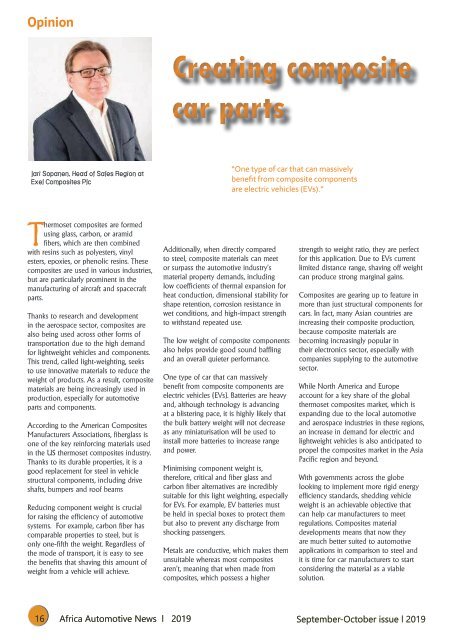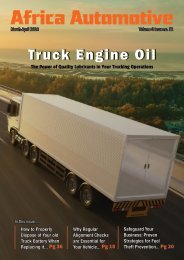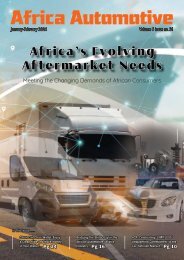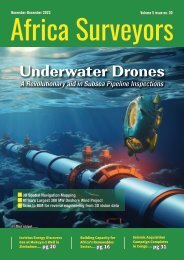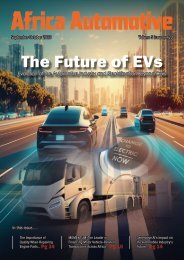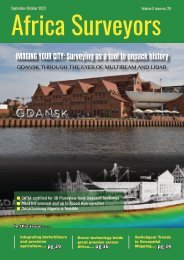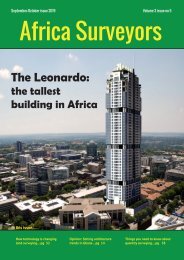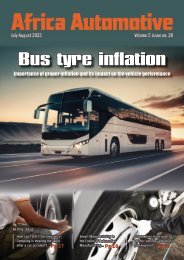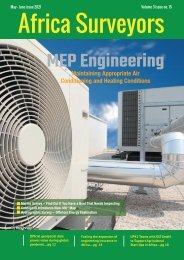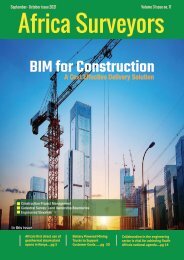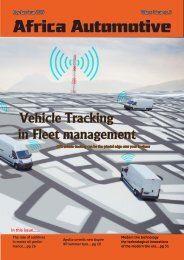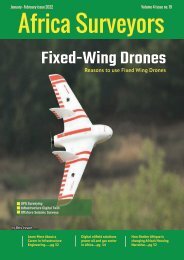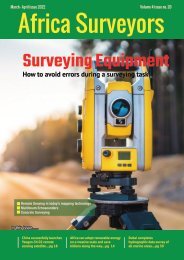Africa Automotive News September-October digital issue 2019
Africa Automotive prides itself to be the ONLY Africa’s leading and MOST authoritative magazine for the automotive industry in Africa with printed copies for the automotive industry decision makers in both government, NGO’s and private sector. The Bi-monthly magazine offers cost effective advertising services that get results and improves growth in the auto B2C and B2B sector, keeping an eye on latest technologies in Africa and across the world, the magazine predominately covers the developments in the Africa auto industry.
Africa Automotive prides itself to be the ONLY Africa’s leading and MOST authoritative magazine for the automotive industry in Africa with printed copies for the automotive industry decision makers in both government, NGO’s and private sector. The Bi-monthly magazine offers cost effective advertising services that get results and improves growth in the auto B2C and B2B sector, keeping an eye on latest technologies in Africa and across the world, the magazine predominately covers the developments in the Africa auto industry.
You also want an ePaper? Increase the reach of your titles
YUMPU automatically turns print PDFs into web optimized ePapers that Google loves.
Opinion<br />
Creating composite<br />
car parts<br />
Jari Sopanen, Head of Sales Region at<br />
Exel Composites Plc<br />
“One type of car that can massively<br />
benefit from composite components<br />
are electric vehicles (EVs).”<br />
Thermoset composites are formed<br />
using glass, carbon, or aramid<br />
fibers, which are then combined<br />
with resins such as polyesters, vinyl<br />
esters, epoxies, or phenolic resins. These<br />
composites are used in various industries,<br />
but are particularly prominent in the<br />
manufacturing of aircraft and spacecraft<br />
parts.<br />
Thanks to research and development<br />
in the aerospace sector, composites are<br />
also being used across other forms of<br />
transportation due to the high demand<br />
for lightweight vehicles and components.<br />
This trend, called light-weighting, seeks<br />
to use innovative materials to reduce the<br />
weight of products. As a result, composite<br />
materials are being increasingly used in<br />
production, especially for automotive<br />
parts and components.<br />
According to the American Composites<br />
Manufacturers Associations, fiberglass is<br />
one of the key reinforcing materials used<br />
in the US thermoset composites industry.<br />
Thanks to its durable properties, it is a<br />
good replacement for steel in vehicle<br />
structural components, including drive<br />
shafts, bumpers and roof beams<br />
Reducing component weight is crucial<br />
for raising the efficiency of automotive<br />
systems. For example, carbon fiber has<br />
comparable properties to steel, but is<br />
only one-fifth the weight. Regardless of<br />
the mode of transport, it is easy to see<br />
the benefits that shaving this amount of<br />
weight from a vehicle will achieve.<br />
Additionally, when directly compared<br />
to steel, composite materials can meet<br />
or surpass the automotive industry’s<br />
material property demands, including<br />
low coefficients of thermal expansion for<br />
heat conduction, dimensional stability for<br />
shape retention, corrosion resistance in<br />
wet conditions, and high-impact strength<br />
to withstand repeated use.<br />
The low weight of composite components<br />
also helps provide good sound baffling<br />
and an overall quieter performance.<br />
One type of car that can massively<br />
benefit from composite components are<br />
electric vehicles (EVs). Batteries are heavy<br />
and, although technology is advancing<br />
at a blistering pace, it is highly likely that<br />
the bulk battery weight will not decrease<br />
as any miniaturisation will be used to<br />
install more batteries to increase range<br />
and power.<br />
Minimising component weight is,<br />
therefore, critical and fiber glass and<br />
carbon fiber alternatives are incredibly<br />
suitable for this light weighting, especially<br />
for EVs. For example, EV batteries must<br />
be held in special boxes to protect them<br />
but also to prevent any discharge from<br />
shocking passengers.<br />
Metals are conductive, which makes them<br />
unsuitable whereas most composites<br />
aren’t, meaning that when made from<br />
composites, which possess a higher<br />
strength to weight ratio, they are perfect<br />
for this application. Due to EVs current<br />
limited distance range, shaving off weight<br />
can produce strong marginal gains.<br />
Composites are gearing up to feature in<br />
more than just structural components for<br />
cars. In fact, many Asian countries are<br />
increasing their composite production,<br />
because composite materials are<br />
becoming increasingly popular in<br />
their electronics sector, especially with<br />
companies supplying to the automotive<br />
sector.<br />
While North America and Europe<br />
account for a key share of the global<br />
thermoset composites market, which is<br />
expanding due to the local automotive<br />
and aerospace industries in these regions,<br />
an increase in demand for electric and<br />
lightweight vehicles is also anticipated to<br />
propel the composites market in the Asia<br />
Pacific region and beyond.<br />
With governments across the globe<br />
looking to implement more rigid energy<br />
efficiency standards, shedding vehicle<br />
weight is an achievable objective that<br />
can help car manufacturers to meet<br />
regulations. Composites material<br />
developments means that now they<br />
are much better suited to automotive<br />
applications in comparison to steel and<br />
it is time for car manufacturers to start<br />
considering the material as a viable<br />
solution.<br />
16 <strong>Africa</strong> <strong>Automotive</strong> <strong>News</strong> l <strong>2019</strong> <strong>September</strong>-<strong>October</strong> <strong>issue</strong> l <strong>2019</strong>


